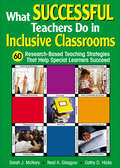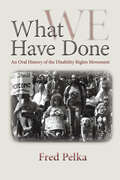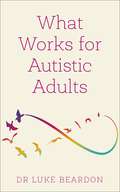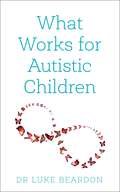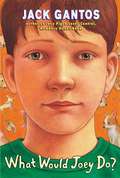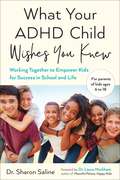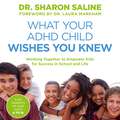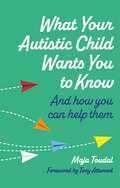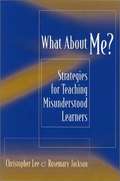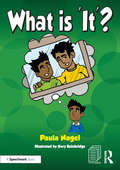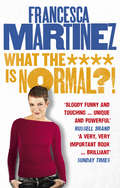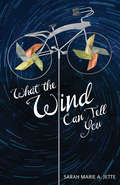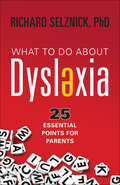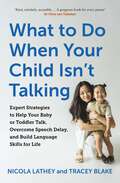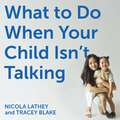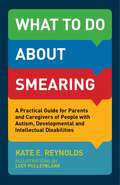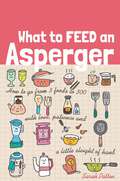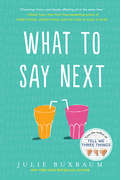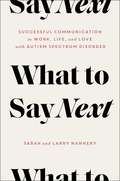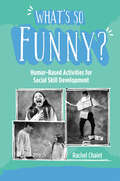- Table View
- List View
What Successful Teachers Do in Inclusive Classrooms: 60 Research-Based Teaching Strategies That Help Special Learners Succeed
by Neal A. Glasgow Cathy D. Hicks Sarah J. McnaryTest-drive these research-based strategies in your inclusive classroom! Bridging the gap between theory and practice, this book focuses on extending academic research to classroom practices that address the problems faced by teachers working with special needs learners in inclusive classrooms. It outlines a full range of research-based strategies that can be interwoven and tailored to create the best instructional plan for special learners, including: A straightforward one-line action statement An easy-to-read synthesis of relevant studies Specific tactics for immediate application in the classroom Pointers on how to identify and avoid potential pitfalls Sources for further reading on the research/strategy outlined
What We Have Done: An Oral History of the Disability Rights Movement
by Fred Pelka"Nothing about us without us" has been a core principle of American disability rights activists for more than half a century. It represents a response by people with disabilities to being treated with scorn and abuse or as objects of pity, and to having the most fundamental decisions relating to their lives--where they would live; if and how they would be educated; if they would be allowed to marry or have families; indeed, if they would be permitted to live at all--made by those who were, in the parlance of the movement, "temporarily able-bodied." In What We Have Done: An Oral History of the Disability Rights Movement, Fred Pelka takes that slogan at face value. He presents the voices of disability rights activists who, in the period from 1950 to 1990, transformed how society views people with disabilities, and recounts how the various streams of the movement came together to push through the Americans with Disabilities Act of 1990, the most sweeping civil rights legislation since passage of the Civil Rights Act of 1964. Beginning with the stories of those who grew up with disabilities in the 1940s and '50s, the book traces how disability came to be seen as a political issue, and how people with disabilities--often isolated, institutionalized, and marginalized--forged a movement analogous to the civil rights, women's rights, and gay rights movements, and fought for full and equal participation in American society.
What Works for Autistic Adults
by Luke Beardon'This book has the power to change lives' Chris PackhamImagine a world where an autistic person is included, engaged and cherished for how they are; a world which changes for autistic people, rather than changing the person.What Works for Autistic Adults brings the conversation about inclusivity into the forefront and turns it on its head. Instead of modifying the autistic individual and making exceptions or special circumstances, Luke shows how the world can, should and must change to accommodate your needs or those of the autistic person you love, live or work with.He identifies the aspects that impact on life most - partners, friends, work or college, and environment - and outlines the steps that can and should be taken by everyone involved to create an autism-friendly landscape and improve outcomes all round. Covering every setting, from social situations to office or other professional environments, and in all circumstances, Luke's book shows how no-one should have to struggle to exist within the parameters of a world they don't understand. What Works for Autistic Adults will give you the dialogue, tools and starting points to involve every loved one, family member or colleague as advocates for a world where you, or any other autistic adult, can truly flourish.
What Works for Autistic Adults
by Luke Beardon'This book has the power to change lives' Chris PackhamImagine a world where an autistic person is included, engaged and cherished for how they are; a world which changes for autistic people, rather than changing the person.What Works for Autistic Adults brings the conversation about inclusivity into the forefront and turns it on its head. Instead of modifying the autistic individual and making exceptions or special circumstances, Luke shows how the world can, should and must change to accommodate your needs or those of the autistic person you love, live or work with.He identifies the aspects that impact on life most - partners, friends, work or college, and environment - and outlines the steps that can and should be taken by everyone involved to create an autism-friendly landscape and improve outcomes all round. Covering every setting, from social situations to office or other professional environments, and in all circumstances, Luke's book shows how no-one should have to struggle to exist within the parameters of a world they don't understand. What Works for Autistic Adults will give you the dialogue, tools and starting points to involve every loved one, family member or colleague as advocates for a world where you, or any other autistic adult, can truly flourish.
What Works for Autistic Children
by Luke BeardonImagine a world where your autistic child is included, engaged and cherished for how they are; a world which changes for autistic children, rather than changing the child.What Works for Autistic Children brings the conversation about inclusivity into the forefront and turns it on its head. Instead of modifying the autistic child and making exceptions or special circumstances, Luke shows you, the parent, how the world can, should and must change to accommodate your child. He identifies the aspects that impact on your child's life most - the family, their school, their friends, their environment - and outlines the steps that can and should be taken by everyone involved to improve their outcome and create an autism-friendly landscape.From early communication, through pre-school, primary school, secondary school - on holidays, school trips and with friends - your child should not have to struggle to exist within the parameters of a world they don't understand. What Works for Autistic Children will give you the dialogue, tools and starting points to involve every professional and family member as advocates for a world where your child flourishes.
What Works for Autistic Children
by Luke BeardonImagine a world where your autistic child is included, engaged and cherished for how they are; a world which changes for autistic children, rather than changing the child.What Works for Autistic Children brings the conversation about inclusivity into the forefront and turns it on its head. Instead of modifying the autistic child and making exceptions or special circumstances, Luke shows you, the parent, how the world can, should and must change to accommodate your child. He identifies the aspects that impact on your child's life most - the family, their school, their friends, their environment - and outlines the steps that can and should be taken by everyone involved to improve their outcome and create an autism-friendly landscape.From early communication, through pre-school, primary school, secondary school - on holidays, school trips and with friends - your child should not have to struggle to exist within the parameters of a world they don't understand. What Works for Autistic Children will give you the dialogue, tools and starting points to involve every professional and family member as advocates for a world where your child flourishes.
What Would Joey Do? (Joey Pigza #3)
by Jack GantosJack Gantos' acclaimed hero is attempting a breathtaking balancing act, as he tries to keep a handle on his wild, wired behavior without letting his hyperactivity spin him out of control all over again. This is truly a touching story, where Joey makes a friend with another child with disabilities, and finally comes to terms with his dysfunctional family.
What Your ADHD Child Wishes You Knew: Working Together to Empower Kids for Success in School and Life
by Dr Laura Markham Dr Sharon SalineA veteran psychologist presents a proven roadmap to help ADHD kids succeed in school and life You’ve read all the expert advice, but despite countless efforts to help your child cope better and stay on track, you’re still struggling with everyday issues like homework, chores, getting to soccer practice on time, and simply getting along without pushback and power struggles. What if you could work with your child, motivating and engaging them in the process, to create positive change once and for all? In this insightful and practical book, veteran psychologist Sharon Saline shares the words and inner struggles of children and teens living with ADHD—and a blueprint for achieving lasting success by working together. Based on more than 25 years of experience counseling young people and their families, Dr. Saline’s advice and real-world examples reveal how parents can shift the dynamic and truly help kids succeed. Topics include: * Setting mutual goals that foster cooperation* Easing academic struggles* Tackling everyday challenges, from tantrums and backtalk to staying organized, building friendships, and more. With useful exercises and easy-to-remember techniques, you’ll discover a variety of practical strategies that really work, creating positive change that will last a lifetime.
What Your ADHD Child Wishes You Knew: Working Together to Empower Kids for Success in School and Life
by Dr Sharon SalineWhat if you could work with your child, motivating and engaging them in the process, to create positive change once and for all? In this insightful and practical book, veteran psychologist Sharon Saline shares the words and inner struggles of children and teens living with ADHD-and a blueprint for achieving lasting success by working together. Based on more than 25 years of experience counseling young people and their families, Dr. Saline's advice and real-world examples reveal how parents can shift the dynamic and truly help kids succeed. Topics include:Setting mutual goals that foster cooperationEasing academic strugglesTackling everyday challenges, from tantrums and backtalk to staying organized, building friendships, and more.With useful exercises and easy-to-remember techniques, you'll discover a variety of practical strategies that really work, creating positive change that will last a lifetime.
What Your Autistic Child Wants You to Know: And How You Can Help Them
by Maja Toudal"There are so many things I wish I could have told my parents when I was a child, but back then I did not have the words."It can be challenging understanding what your autistic child wants and needs, at times it can feel like a struggle to ask the right questions and find the right words.Written by autistic academic and advocate, Maja Toudal, in collaboration with other autistic voices, this candid book explores a range of common situational and social challenges an autistic young person may face and gives lived-experience advice on how to resolve them. Maja offers insights on everything from making mealtimes work for your child, to handling bullying and peer pressure, both at school and on social media, providing an insider's guide into the child's emotional life.With relatable and engaging advice on what your child needs and why, alongside chapters focusing on how to approach puberty, providing coping mechanisms for meltdowns, and offering insight into making safe spaces, this is the essential guide to parenting autistic young people.
What about Me?: Strategies for Teaching Misunderstood Learners
by Christopher M. Lee Rosemary F. JacksonWith Faking It, Christopher Lee and Rosemary Jackson offered a moving account of Lee's struggle and ultimate triumph over dyslexia. Now, Lee combines his special insight with Jackson's expertise as a special education trainer to offer specific help to teachers and parents of other misunderstood learners.
What is it?: But What If...; Mind Reading; Stuck On A Loop; Waht Is It? (Rollercoaster Series)
by Paula NagelThis is a focus on low mood associated with bereavement. Sam feels low and fed up, but doesn't understand why he feels this way. Everyone else has an opinion on the change in his behaviour. His teacher thinks he is being lazy and can't be bothered to finish his work, his mum thinks he is moody and bad tempered, his friends think he is no fun any more and turning into a bore. Comments like, 'Cheer up it might never happen', ' What has got into you?' and 'Do you want to talk about it?' just upset him even more. He doesn't know what the 'it' is, that is making him feel this way. He didn't even feel this bad when his cousin died a year ago! When he is kept behind in class for not completing his work he tells the teacher how confused and sad he feels. Connections are made between his feelings and the looming anniversary of his cousin's death. Sam is helped to understand that thoughts and feelings associated with bereavement can come and go for a long time, and can cause strong emotions. He is shown how to notice and share his feelings and to think about things he can do when he feels this way. He makes a memory box so he can also remember all the happy things about his cousin. In the 'Let's talk about .sadness and loss,' section, feelings associated with bereavement and helpful coping strategies are shared. Paul Nagel has worked as an educational psychologist for 17 years. This has included working as a Lead Professional Educational Psychologist managing a traded service, as well as holding Senior Specialist posts for early years and disability. Over the years Paula has worked in multi agency teams within paediatric services, youth offending teams, Sure Start and an anti bullying service. She is currently Principal Educational Psychologist (North) for the national children's mental health charity, Place2Be. Before qualifying as an Educational Psychologist Paula was a primary school teacher. Gary Bainbridge is an artist, comics creator and secondary school Art, Photography and Media Studies teacher from Durham. He's best known for the North East based kitchen sink superhero comic Sugar Glider and the Newcastle-set crime fiction comic, Nightbus. Gary teaches at an academy in Northumberland.
What of the Blind? A Survey of the Development and Scope of Present-Day Work with the Blind: Volume 1
by Helga LendeWhat of the Blind? is designed with a view to presenting in one single volume the experience and opinions of leaders in this specialized field. The material has been grouped so that the student may easily find the aspect of the subject in which he is especially interested. Following each chapter is a short reading list which will serve as a guide to further study.
What of the Blind? A Survey of the Development and Scope of Present-Day Work with the Blind: Volume 2
by Helga LendeThis book is intended as a companion volume to What of the Blind? Recently published by the American Foundation for the Blind. The first volume was brought out in answer to a long-felt need for a convenient reference work to put in the hands of professional workers, board members and lay persons desiring general information on work with the blind. The subjects treated were mainly of a general nature as will be seen from the table of contents appended to this book.
What the **** is Normal?!
by Francesca MartinezIf you grow up in a world where wrinkles are practically illegal, going bald is cause for a mental breakdown, and women over size zero are encouraged to shoot themselves (immediately), what the hell do you do if you’re, gasp … DISABLED? Whatever body you’re born into, the pressure to be normal is everywhere. But have you ever met a normal person? What do they look like? Where do they live? What do they eat for breakfast?And what the **** does normal mean anyway?This is the award-winning wobbly comedian Francesca Martinez’s funny, personal, and universal story of how she learned to stick two shaky fingers up to the crazy expectations of a world obsessed with being ‘normal’.
What the Wind Can Tell You
by Sarah Marie JetteIsabelle is fascinated by wind. And this year, she’s determined to win the middle school science fair with her wind machine. She’s just as determined to have her brother, Julian, who lives with a severe form of epilepsy and uses a wheelchair, serve as her assistant. But after Julian has a grand seizure, everything changes. Isabelle is suddenly granted entry into Las Brisas, a magical world where Julian’s physical limitations disappear, and one, she discovers, that he visits every night. The more Isabelle explores Las Brisas, the more possibilities she sees—for Julian, and for herself—and the more she finds herself at odds with her parents. Debut author Sarah Marie A. Jette has told, with remarkable insight and humor, a powerful story of a family struggling to love without fear.
What to Do About Dyslexia: 25 Essential Points for Parents
by Richard SelznickWhen children struggle with reading, spelling, and writing, their parents often feel at a loss as to how to help and where to turn for guidance. Common questions include: Does my child have dyslexia? What is dyslexia? What is multisensory instruction? What does remediation involve? How is dyslexia assessed? Who should do the assessment? What is the school's role? What about private vs. special education assessment? What are the implications for the future? Even with information readily available on the internet, parents are overwhelmed, confused, and unclear about the appropriate direction to take.Offering readers the same support and honest advice he gives the parents he sees in his practice, in this new book Dr. Selznick uses plain language to make dyslexia understandable and cut through the confusion. It's like sitting in a living room, chatting with a knowledgeable relative or friend who's concerned about your child. Dr. Selznick offers hope but remains grounded in reality―he doesn't sugar-coat the issues. His 25 essential points include the definition and characteristics of dyslexia, how dyslexia is assessed, how to approach remediation, and tips to help you and your child conquer the most common learning disability.
What to Do About Your Brain-Injured Child
by Glenn DomanGlenn Doman—pioneer in the treatment of the brain-injured children and founder of The Institutes for the Achievement of Human Potential—brings hope to thousands of children who have been sentenced to a life of institutional confinement.In What To Do About Your Brain-Injured Child, Doman recounts the story of The Institutes&’ tireless effort to refine treatment of the brain injured. He shares the staff&’s lifesaving techniques and the tools used to measure—and ultimately improve—visual, auditory, tactile, mobile, and manual development. Doman explains the unique methods of treatment, and then describes the program with which parents can work with their own children at home in a familiar and loving environment. Included throughout are case histories, drawings, and helpful charts and diagrams.
What to Do When Your Child Isn’t Talking: Expert Strategies to Help Your Baby or Toddler Talk, Overcome Speech Delay, & Build Language Skills for Life
by Nicola Lathey Tracey Blake'Kind, scholary, accessible... A gorgeous book for every parent' Dr Chris Van TullekenThe stress, anxiety, and isolation of the past few years have led to a crisis among young children. Many toddlers who had been chatting away stopped altogether while others never developed language skills at all. Speech and language therapist Nicola Lathey and journalist Tracey Blake are on a mission to get your child back on track--with strategies tailored to specific needs:- What if your baby isn't babbling in year one?- What if your toddler isn't saying their first words in year two?- What if your child isn't talking in sentences like their peers in year three?What to Do When Your Child Isn't Talking answers parents' burning questions about their child's development and provides expert strategies to put this advice into practice. With each chapter devoted to a language setback and solution, this book provides practical advice and fun games for parents to steer their children back on track and set them up for success at school and in life.
What to Do When Your Child Isn’t Talking: Expert Strategies to Help Your Baby or Toddler Talk, Overcome Speech Delay, & Build Language Skills for Life
by Nicola Lathey Tracey BlakeAn essential guide to language development - from babbling, to first words, to full sentences - plus, how to support the speech of autistic children or children with ADHD.The stress, anxiety, and isolation of the past few years have led to a crisis among young children. Many toddlers who had been chatting away stopped altogether while others never developed language skills at all. Speech and language therapist Nicola Lathey and journalist Tracey Blake are on a mission to get your child back on track--with strategies tailored to specific needs:- What if your baby isn't babbling in year one?- What if your toddler isn't saying their first words in year two?- What if your child isn't talking in sentences like their peers in year three?What to Do When Your Child Isn't Talking answers parents' burning questions about their child's development and provides expert strategies to put this advice into practice. With each chapter devoted to a language setback and solution, this book provides practical advice and fun games for parents to steer their children back on track and set them up for success at school and in life.(P) 2023 Tantor Audio
What to Do about Smearing: A Practical Guide for Parents and Caregivers of People with Autism, Developmental and Intellectual Disabilities
by Kate E. Reynolds Lucy PulleyblankAddressing the often hidden, yet not uncommon, behaviour of faecal smearing among children and adults with autism and developmental and intellectual disabilities, this practical handbook shows how to tackle this often embarrassing and difficult issue in a positive way. Informing parents and caregivers of the many causes of smearing, the author offers tried-and-tested, everyday approaches for managing this behaviour. This supportive guidebook includes down-to-earth advice, helpful picture narratives, examples of how to prepare and use diary sheets for behaviour analysis, and practical exercises that can be carried out at home. There is also advice on what to do if a child ingests faeces, and dealing with persistent or recurring smearing. With a focus on positive low-arousal responses and featuring the voices of parents who have experience of their child's smearing, families will feel supported and confident in identifying the causes of smearing, and be able to choose and carry out appropriate preventative approaches. This will also be a useful resource for professionals who encounter smearing behaviour, including social workers and SEN and teaching staff.
What to Feed an Asperger: How to go from 3 foods to 300 with love, patience and a little sleight of hand
by Sarah PattenPacked full of tips and tricks to improve the diet of super sensitive Asperger kids, this book is a must read for parents who want to help their children overcome food avoidance and sensory sensitivities. Sarah Patten shows other parents that they are far from alone in their struggle to get their children to eat a varied and well-balanced diet. She describes how, through a combination of love, patience and a little sleight of hand, she managed to get her son to go from eating just three bland white foods to eating a colourful and nutritious diet including fruit and vegetables. Providing recipes for many simple, healthy meals given the Asperger seal of approval, as well as advice for making mealtime routines, eating together as a family and eating out as stress-free as possible, the book provides a wealth of ideas and strategies for moving towards a more varied and nutritious diet. It also includes food diaries and charts to make planning meals and tracking progress simple.
What to Say Next
by Julie Buxbaum<p>From the New York Times bestselling author of <i>Tell Me Three Things</i> comes a charming and poignant story about two struggling teenagers who find an unexpected connection just when they need it most. For fans of Sophie Kinsella, Jennifer Niven, and Rainbow Rowell. <p>Sometimes a new perspective is all that is needed to make sense of the world. <p>KIT: I don’t know why I decide not to sit with Annie and Violet at lunch. It feels like no one here gets what I’m going through. How could they? I don’t even understand. <p>DAVID: In the 622 days I’ve attended Mapleview High, Kit Lowell is the first person to sit at my lunch table. I mean, I’ve never once sat with someone until now. “So your dad is dead,” I say to Kit, because this is a fact I’ve recently learned about her. <p>When an unlikely friendship is sparked between relatively popular Kit Lowell and socially isolated David Drucker, everyone is surprised, most of all Kit and David. Kit appreciates David’s blunt honesty—in fact, she finds it bizarrely refreshing. David welcomes Kit’s attention and her inquisitive nature. When she asks for his help figuring out the how and why of her dad’s tragic car accident, David is all in. But neither of them can predict what they’ll find. Can their friendship survive the truth?
What to Say Next: Successful Communication in Work, Life, and Love—with Autism Spectrum Disorder
by Sarah Nannery Larry NanneryUsing her personal experience living as a professional woman with Autism Spectrum Disorder, Sarah Nannery, together with her husband, Larry, offers this timely communication guide for anyone on the Autism spectrum looking to successfully navigate work, life, and love. When Sarah Nannery got her first job at a small nonprofit, she thought she knew exactly what it would take to advance. But soon she realized that even with hard work and conscientiousness, she was missing key meanings and messages embedded in her colleagues&’ everyday requests, feedback, and praise. She had long realized her brain operated differently than others, but now she knew for sure: she had Autism Spectrum Disorder (ASD). With help from her neurotypical partner—now husband—Larry, mostly in frantic IM chats, Sarah rose to Director of Development at one of the world&’s largest nonprofits. Together they have tackled challenges in how Sarah navigates personal and professional relationships, how they navigate marriage and parenthood, all of which are differently challenging for someone with ASD. But she wonders, at times, how life would be different if she&’d had to figure it all out herself. So, in What to Say Next, she offers advice, empathy, and straightforward strategies from her own tool-kit—not only for others who see the world differently, but for their families, partners and colleagues. In What to Say Next, Sarah breaks down everyday situations—the chat in the break room, the last-minute meeting, the unexpected run-in—in granular detail, explaining not only how to understand the goals of others, but also how to frame your own. Larry adds his thoughts from a neurotypical perspective, sharing what was going on in his brain and how he learned to listen and enlighten, while supporting and maintaining Sarah&’s voice. At a time when more and more people are being diagnosed with ASD—especially women and girls—this book tells important truths about what it takes to make it in a neurotypical world, and still be true to yourself.
What's So Funny?: Humor-Based Activities for Social Skill Development
by Rachel ChaietWith ready-to-use lessons and strategies, What’s So Funny?: Humor-Based Activities for Social Skill Development provides readers with tools to help their clients improve their emotional intelligence through humor. Occupational therapists, speech-language pathologists, special educators, behavior therapists, and caregivers will benefit from the implementation of these strategies.What’s So Funny? contains a curriculum of more than 50 activities that emphasize two main ideas. The first is that humor (linguistic or physical) can be taught to many individuals with autism spectrum disorder or other disorders through explicit instruction, exposure to various types of humor, and embracing the individual’s preferred sense of humor. The second is that humorous activities can be used to increase social engagement, which can sometimes be a challenge for those with developmental disabilities.What’s So Funny? includes activities essential for individuals who: Appear to have a very limited concept or basic developmental level of humor Need to improve their understanding of socially appropriate humor Lack understanding of appropriate times to use humor Are nonverbal, have limited expressive communication skills, or use augmentative communication devices Have a difficult time initiating social interactions with their peers With a flexible program that can be used for either small groups or individuals from ages 7 years to adult, What’s So Funny?: Humor-Based Activities for Social Skill Development is a relevant and easy-to-use resource. Discussing a variety of types of humor on different developmental levels, from slapstick to word play, this program improves participants’ abilities to connect and engage with others through the powerful tool of humor.
